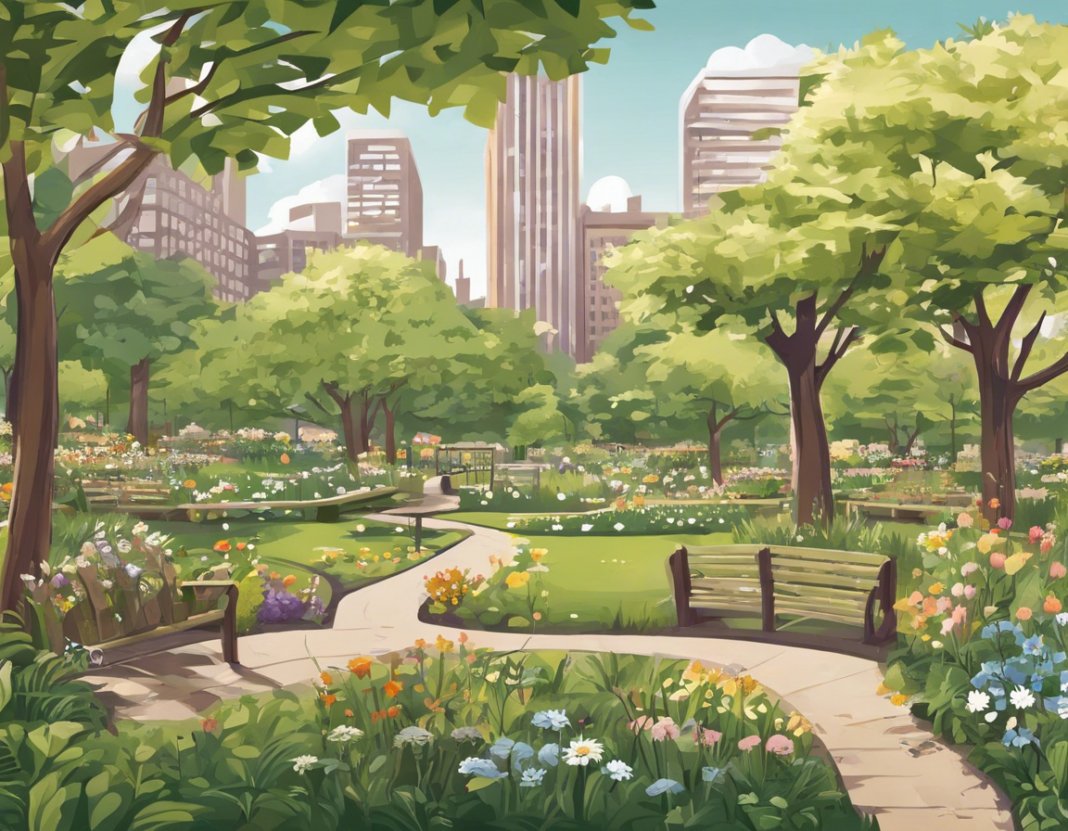Imagine strolling through a lush oasis of greenery in the midst of a bustling metropolis, where the sound of chirping birds and flowing water replaces the honking of cars and the chatter of pedestrians. City gardens offer a peaceful refuge for nature lovers seeking respite from urban life. These enchanting green spaces not only provide a visual feast of colorful blooms and majestic trees but also contribute to the well-being of city dwellers by offering a connection to nature and promoting a sense of tranquility. In this comprehensive guide, we will delve into the world of city gardens and explore their beauty, significance, and the benefits they bring to urban environments.
The Beauty of City Gardens
City gardens are a celebration of nature within the concrete jungle, showcasing a harmonious blend of flora and fauna in carefully curated landscapes. From sprawling botanical gardens to intimate pocket parks, each city garden has its own unique charm and character. Floral displays burst with vibrant hues, from the delicate petals of roses to the exotic blooms of orchids, creating a stunning visual spectacle that delights visitors of all ages.
Trees stand tall and majestic, offering shade and shelter to weary travelers seeking refuge from the harsh sun. Some city gardens boast ancient specimens that have witnessed the passage of time, their gnarled branches reaching towards the sky like outstretched arms. The rustling of leaves and the gentle swaying of branches create a soothing symphony that lulls visitors into a state of peaceful contemplation.
Water features add a touch of serenity to city gardens, with shimmering ponds, cascading fountains, and meandering streams reflecting the sunlight and creating a sense of movement and life. The tranquil sound of flowing water acts as a natural balm for the soul, washing away the stresses of daily life and instilling a sense of calm and relaxation.
The Significance of City Gardens
City gardens play a crucial role in enhancing the quality of urban life and promoting sustainability in densely populated areas. These green spaces act as lungs for the city, absorbing carbon dioxide and releasing oxygen, thereby improving air quality and mitigating the effects of pollution. The presence of plants and trees also helps to reduce urban heat islands, where concrete and asphalt surfaces trap heat and raise temperatures, making cities unbearably hot during the summer months.
In addition to their environmental benefits, city gardens contribute to the mental health and well-being of urban residents. Studies have shown that exposure to nature can reduce stress, anxiety, and depression, leading to improved overall mood and cognitive function. In today’s fast-paced world, city gardens offer a much-needed retreat where people can unwind, recharge, and reconnect with the natural world.
Furthermore, city gardens act as biodiversity hotspots, providing a safe haven for a variety of plant and animal species in an otherwise hostile urban environment. By creating habitats for birds, insects, and other wildlife, city gardens help to preserve ecological diversity and promote a balanced ecosystem where different organisms can thrive.
The Benefits of City Gardens
The benefits of city gardens extend far beyond their aesthetic appeal, encompassing physical, mental, social, and environmental aspects that contribute to a holistic sense of well-being. Let’s explore some of the key advantages that city gardens offer to both individuals and communities:
1. Physical Health:
City gardens provide opportunities for exercise and physical activity, whether through leisurely walks, yoga sessions, or gardening tasks. Engaging in outdoor activities in a green environment can improve cardiovascular health, strengthen muscles, and boost overall fitness levels.
2. Mental Well-being:
Spending time in nature has been linked to stress reduction, improved mood, and enhanced cognitive function. City gardens offer a peaceful retreat where people can escape the pressures of urban life and find solace in the beauty of the natural world.
3. Community Engagement:
City gardens serve as community hubs where residents can gather for events, workshops, and cultural activities. These shared spaces foster a sense of belonging and connection among neighbors, promoting social interaction and cohesion.
4. Educational Opportunities:
Many city gardens offer educational programs and workshops that teach visitors about gardening, sustainability, and environmental conservation. These initiatives help to raise awareness about ecological issues and inspire people to take action to protect the planet.
5. Urban Regeneration:
By transforming vacant lots, abandoned spaces, and derelict buildings into vibrant green oases, city gardens contribute to urban revitalization and regeneration. These green transformations beautify neighborhoods, attract visitors, and stimulate economic growth.
6. Climate Resilience:
City gardens play a role in building climate resilience by absorbing rainwater, reducing flooding, and providing cooling effects during heatwaves. Green infrastructure elements, such as green roofs and rain gardens, help to manage stormwater and combat the effects of climate change.
Exploring City Gardens Around the World
City gardens can be found in every corner of the globe, each offering a unique glimpse into the local flora, fauna, and culture of its region. Let’s take a virtual tour of some of the most enchanting city gardens around the world:
1. Keukenhof Gardens, Netherlands:
Known as the “Garden of Europe,” Keukenhof Gardens is a paradise of tulips, daffodils, and other spring bulbs, creating a kaleidoscope of color that attracts millions of visitors each year.
2. Butchart Gardens, Canada:
Located on Vancouver Island, Butchart Gardens features sunken gardens, rose gardens, and Japanese gardens that showcase the beauty of the Pacific Northwest’s flora and fauna.
3. Kirstenbosch National Botanical Garden, South Africa:
Nestled at the foot of Table Mountain, Kirstenbosch is a biodiversity hotspot with indigenous plants, sweeping lawns, and treetop canopy walks that offer panoramic views of Cape Town.
4. Shinjuku Gyoen National Garden, Japan:
A tranquil oasis in the heart of Tokyo, Shinjuku Gyoen boasts traditional Japanese gardens, cherry blossoms, and tea houses where visitors can experience the serenity of Zen.
5. Singapore Botanic Gardens, Singapore:
A UNESCO World Heritage Site, the Singapore Botanic Gardens features orchid gardens, palm valley, and healing gardens that showcase the rich botanical heritage of Southeast Asia.
Frequently Asked Questions (FAQs) About City Gardens
1. What is the difference between a city garden and a public park?
- City gardens are typically more formal and designed, often featuring curated plant collections, themed displays, and architectural elements. Public parks, on the other hand, are more naturalistic and informal, with open green spaces, playgrounds, and recreational facilities for public use.
2. How can I get involved in volunteering at a city garden?
- Many city gardens have volunteer programs that welcome individuals interested in gardening, horticulture, and environmental stewardship. Contact the garden’s administration or visit their website to learn more about volunteer opportunities.
3. Are city gardens sustainable?
- City gardens strive to incorporate sustainable practices in their design and maintenance, such as water conservation, organic gardening, and recycling. By promoting biodiversity and ecological balance, city gardens contribute to a more sustainable urban environment.
4. Can city gardens help combat climate change?
- Yes, city gardens play a significant role in climate change mitigation by sequestering carbon emissions, reducing urban heat islands, and promoting green infrastructure solutions. Their cooling effects and stormwater management capabilities contribute to building resilient and sustainable cities.
5. What are some tips for creating a city garden at home?
- To create a city garden at home, start by assessing your available space, sunlight exposure, and soil quality. Choose native plants and drought-tolerant species that thrive in urban environments. Incorporate vertical gardening solutions, such as green walls and vertical planters, to maximize your space.
In conclusion, city gardens are more than just green spaces; they are living sanctuaries that embody the beauty, significance, and benefits of nature in the heart of urban landscapes. Whether you seek solace in a peaceful retreat, inspiration in a blooming paradise, or connection in a vibrant community hub, city gardens offer a tapestry of experiences that enrich the mind, body, and soul. As we nurture and cherish these urban oases, we not only preserve the legacy of our natural heritage but also pave the way for a sustainable, resilient future where nature and cities coexist in perfect harmony.






